

Natural Resources
Conservation Service
Ecological site R035XA119AZ
Shallow Loamy 10-14" p.z.
Accessed: 01/10/2025
General information
Provisional. A provisional ecological site description has undergone quality control and quality assurance review. It contains a working state and transition model and enough information to identify the ecological site.
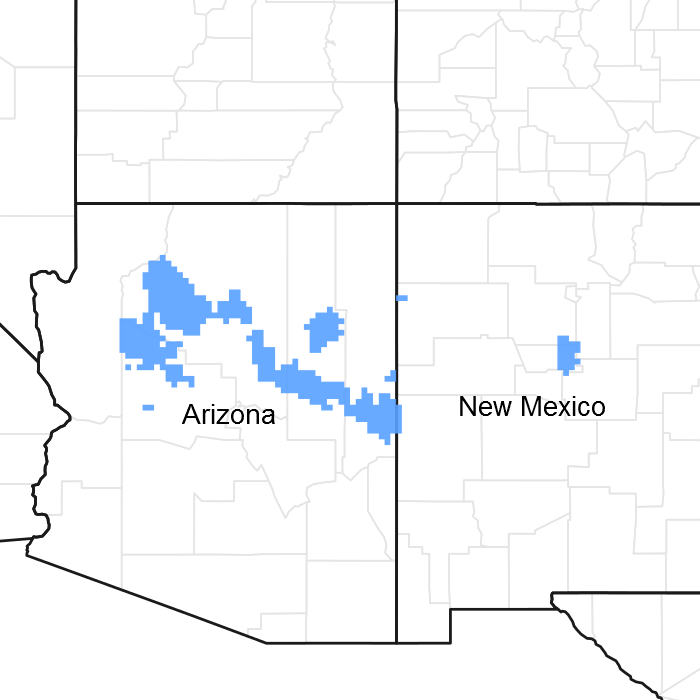
Figure 1. Mapped extent
Areas shown in blue indicate the maximum mapped extent of this ecological site. Other ecological sites likely occur within the highlighted areas. It is also possible for this ecological site to occur outside of highlighted areas if detailed soil survey has not been completed or recently updated.
MLRA notes
Major Land Resource Area (MLRA): 035X–Colorado Plateau
“PROVISIONAL ecological site concepts developed and described. See Project Plan [insert Project Plan Name] for more details and related milestones.”
This ecological site occurs in Land Resource Unit 35.1 - the Colorado Plateau Mixed Grass Plains
Elevations range from 4800 to 6300 feet and precipitation averages 10 to 14 inches per year. Vegetation includes Stipa species, Indian ricegrass, galleta, and blue grama, fourwing saltbush, winterfat, and cliffrose. The soil temperature regime is mesic and the soil moisture regime is ustic aridic. This unit occurs within the Colorado Plateau Physiographic Province and is characterized by a sequence of flat to gently dipping sedimentary rocks eroded into plateaus, valleys and deep canyons. Sedimentary rock classes dominate the plateau with volcanic fields occurring for the most part near its margin.
Ecological site concept
“ATTENTION: This ecological site meets the requirements for PROVISIONAL (if not more). A provisional ecological site is established after ecological site concepts are developed and an initial state-and-transition model is drafted. A provisional ecological site typically will include literature reviews, land use history information, legacy data (prior approved range site descriptions, forage suitability groups, woodland suitability groups, etc.,) , and includes some soils data, and estimates for canopy and/or species composition by weight,. A provisional ecological site provides the conceptual framework of soil-site correlation for the development of the ESD. For more information about this ecological site, please contact your local NRCS office.”
Table 1. Dominant plant species
| Tree |
(1) Juniperus |
|---|---|
| Shrub |
(1) Atriplex canescens |
| Herbaceous |
(1) Hesperostipa comata ssp. comata |
Physiographic features
This site occurs in an upland position on structural benches, mesas and ridges. Slopes generally range from 0-15% with occasional steeper slopes. It does not benefit significantly from run-in moisture or suffer from excessive run-off.
Table 2. Representative physiographic features
| Landforms |
(1)
Mesa
(2) Ridge (3) Structural bench |
|---|---|
| Flooding frequency | None to rare |
| Elevation | 1,463 – 1,920 m |
| Slope | 0 – 15% |
| Aspect | Aspect is not a significant factor |
Climatic features
50-60% of moisture falls as rain Jul-Sept and is the most effective moisture for plant growth. The remaining moisture comes as snow during the winter.
Mean temperatures for the hottest month (Jul) is 72 degrees F; for the coldest month (Jan) is 32 degrees F. Extreme temperatures of 105 degrees F and -26 degrees F have been recorded. Long periods with little or no effective moisture are relatively common.
Cool season plants begin growth in early spring and mature in the early summer. Warm season plants take advantage of the summer rains and grow and retain their nutrition from July through September.
Table 3. Representative climatic features
| Frost-free period (average) | 145 days |
|---|---|
| Freeze-free period (average) | 165 days |
| Precipitation total (average) | 279 mm |
Figure 2. Monthly precipitation range
Figure 3. Monthly average minimum and maximum temperature
Figure 4. Annual precipitation pattern
Figure 5. Annual average temperature pattern
Influencing water features
It does not benefit significantly from run-in moisture or suffer from excessive run-off.
Soil features
Soils in this site are very shallow and shallow (5-20 inches) to limestone, sandstone or basalt bedrock or other plant root restricting layers. The surface soil ranges in texture from a gravelly light clay loam to stony sandy loam about 2-12 inches thick over a weakly to strongly lime cemented layer or bedrock. Soil pH ranges from 7.0 to 8.4. The soils contain coarse fragments from 10 to more than 50 percent by volume. Lime content of the soil varies from 5 to more than 40 percent. Available water capacity is low, and there is medium to rapid runoff.
Typical taxonomic units include:
Coconino County Central part (AZ631) MU's Apache-8; Boysag-62; Cross-3, 8; Daze-9; Deama-9; Winona-60, 61, 62, 64 & 66:
Navajo County Central part (AZ633) MU's Bisoodi fsl-7, 33, 34; Mellenthin-39 & 57:
Yavapai County Western part (AZ637) MU's Apache-As, At, CzC; Boysag-PuC, Cabezon-CzC; Cross-CzC; Dye-DgC, DrC, PvD; Purner-PrC, PsC, PsD, PuC, PvD & PwD; Tortugas-TIB, TmD & TnF:
Little Colorado River Area (AZ707) MU's Cross 2, Mellenthin 25 & 27, Winona 66;
Fort Defiance area (AZ715) MU's Teesto-117; Tekapo family-50; Reef family-50, Tesihim 118.

Figure 6. Soil Pit
Table 4. Representative soil features
| Parent material |
(1)
Pyroclastic flow
–
limestone and sandstone
(2) Colluvium – limestone (3) Residuum – sandstone |
|---|---|
| Surface texture |
(1) Gravelly loam (2) Stony sandy loam (3) Very stony fine sandy loam |
| Family particle size |
(1) Loamy |
| Drainage class | Moderately well drained to well drained |
| Permeability class | Slow to moderate |
| Soil depth | 13 – 51 cm |
| Surface fragment cover <=3" | 5 – 15% |
| Surface fragment cover >3" | 10 – 25% |
| Available water capacity (0-101.6cm) |
6.35 – 12.7 cm |
| Calcium carbonate equivalent (0-101.6cm) |
15 – 50% |
| Electrical conductivity (0-101.6cm) |
0 – 2 mmhos/cm |
| Sodium adsorption ratio (0-101.6cm) |
0 – 5 |
| Soil reaction (1:1 water) (0-101.6cm) |
7 – 8.4 |
| Subsurface fragment volume <=3" (Depth not specified) |
10 – 20% |
| Subsurface fragment volume >3" (Depth not specified) |
5 – 15% |
Ecological dynamics
The plant communities found on an ecological site are naturally variable. Composition and production will vary with yearly conditions, location, aspect, and the natural variability of the soils. The historical climax plant community represents the natural potential plant communities found on relict or relatively undisturbed sites. Other plant communities described here represent plant communities that are known to occur when the site is disturbed by factors such as grazing, fire, or drought.
Production data provided in this site description is standardized to air-dry weight at the end of the summer growing season. The plant communities described in this site description are based on near normal rainfall years.
NRCS uses a Similarity Index to compare existing plant communities to the plant communities described here. Similarity Index is determined by comparing the production and composition of a plant community to the production and composition of a plant community described in this site description. To determine Similarity Index, compare the production (air-dry weight) of each species to that shown in the plant community description. For each species, count no more than the maximum amount shown for the species, and for each group, count no more than the maximum shown for the group. Divide the resulting total by the total normal year production shown in the plant community description. If rainfall has been significantly above or below normal, use the total production shown for above or below normal years. If field data is not collected at the end of the summer growing season, then the field data must be corrected to the end of the year production before comparing it to the site description. The growth curve can be used as a guide for estimating production at the end of the summer growing season.
The State and Transition model shows the most common occurring plant communities likely to be encountered on this ecological site. This model may not show every possible plant community, but only those that are most prevalent and observed through field inventory. As more data is collected and research is available, these plant communities may be revised, removed, and even added to reflect the ecological dynamics of this site.
State and transition model

Figure 7. 35.1AZ Shallow Loamy 10-14"p.z. Reference State
More interactive model formats are also available.
View Interactive Models
More interactive model formats are also available.
View Interactive Models
Click on state and transition labels to scroll to the respective text
Ecosystem states
State 1 submodel, plant communities
State 1
Reference State
The reference state which includes the Historic Climax Plant Community has been determined by study of relict areas or areas protected from excessive disturbances. Trends in plant communities going from heavily grazed areas to lightly grazed areas, seasonal use pastures and historical accounts have also been used. This reference state is characterized as a grassland dominated by cool season grasses with scattered shrubs, forbs and junipers. In this plant community there may be trace amounts, less than 3% by weight, of non-native annuals present; however,they do not change the sites ecological processes in these minor amounts
Community 1.1
Grassland with Mixed Shrubs (HCPC)
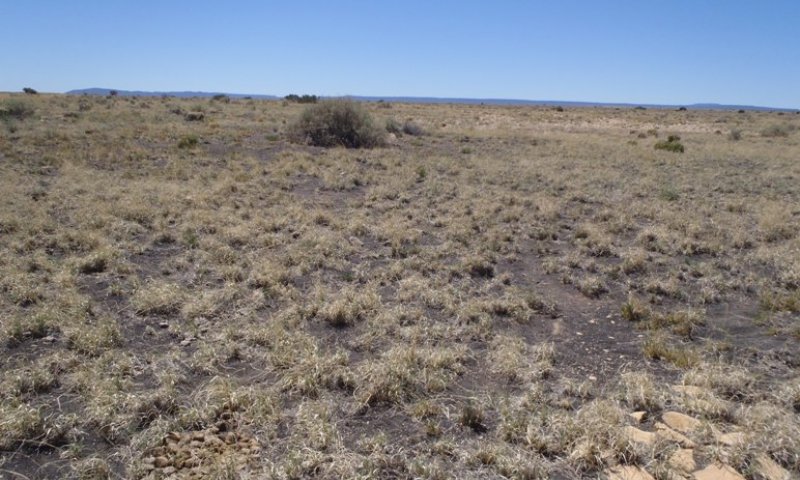
Figure 8. Shallow Loamy 10-14" p.z.
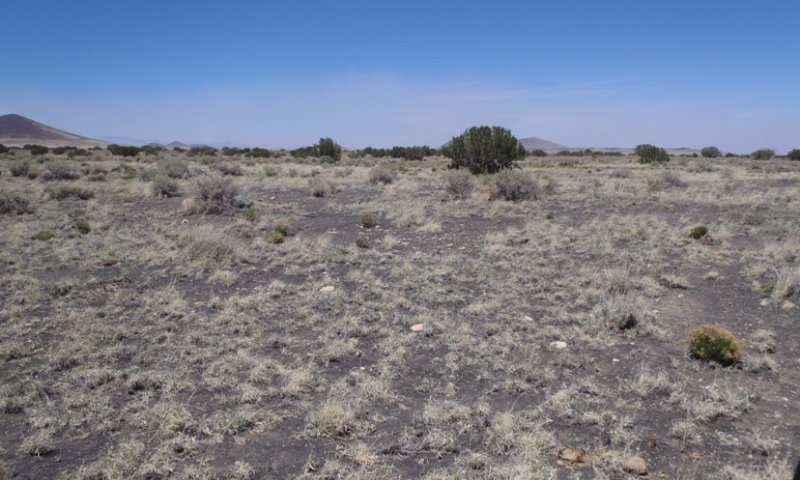
Figure 9. Shallow Loamy 10-14" p.z. High precipitation site
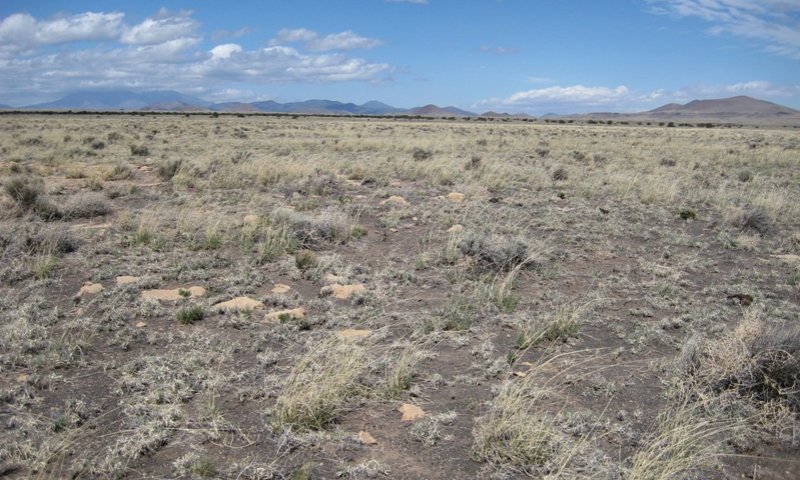
Figure 10. Shallow Loamy 10-14" p.z. Low precipitation site
This plant community is made up primarily of mid and short grasses, shrubs and a relatively small percentage of forbs and a scattered overstory of junipers. There is a mixture of both cool and warm season grasses. Plants most likely to invade or increase on this site are broom snakeweed, wooly groundsel, pingue, juniper, rabbitbrush and annuals. Unmanaged grazing during the winter and spring periods will decrease the cool season grasses, which are replaced by warm season, lower forage value grasses and shrubs. In this plant community there may be trace amounts of non-native annuals present. They do not change the sites ecological processes in these minor amounts
Figure 11. Annual production by plant type (representative values) or group (midpoint values)
Table 5. Annual production by plant type
| Plant type | Low (kg/hectare) |
Representative value (kg/hectare) |
High (kg/hectare) |
|---|---|---|---|
| Grass/Grasslike | 437 | 532 | 639 |
| Shrub/Vine | 73 | 112 | 146 |
| Forb | 39 | 56 | 73 |
| Tree | 11 | 28 | 39 |
| Total | 560 | 728 | 897 |
Table 6. Ground cover
| Tree foliar cover | 0% |
|---|---|
| Shrub/vine/liana foliar cover | 0% |
| Grass/grasslike foliar cover | 0% |
| Forb foliar cover | 0% |
| Non-vascular plants | 0% |
| Biological crusts | 0% |
| Litter | 20-30% |
| Surface fragments >0.25" and <=3" | 5-15% |
| Surface fragments >3" | 10-25% |
| Bedrock | 0% |
| Water | 0% |
| Bare ground | 20-40% |
Table 7. Canopy structure (% cover)
| Height Above Ground (m) | Tree | Shrub/Vine | Grass/ Grasslike |
Forb |
|---|---|---|---|---|
| <0.15 | – | 0-2% | 0-5% | 0-1% |
| >0.15 <= 0.3 | – | 0-5% | 5-10% | 0-2% |
| >0.3 <= 0.6 | – | 0-3% | 5-10% | 0-1% |
| >0.6 <= 1.4 | 0-1% | 0-2% | – | – |
| >1.4 <= 4 | 0-3% | – | – | – |
| >4 <= 12 | – | – | – | – |
| >12 <= 24 | – | – | – | – |
| >24 <= 37 | – | – | – | – |
| >37 | – | – | – | – |
Figure 12. Plant community growth curve (percent production by month). AZ3502, 35.1 10-14" p.z. black grama. Growth occurs mostly during the summer to early fall rainy season..
| Jan | Feb | Mar | Apr | May | Jun | Jul | Aug | Sep | Oct | Nov | Dec |
|---|---|---|---|---|---|---|---|---|---|---|---|
| J | F | M | A | M | J | J | A | S | O | N | D |
| 0 | 0 | 0 | 0 | 5 | 15 | 30 | 30 | 15 | 5 | 0 | 0 |
Figure 13. Plant community growth curve (percent production by month). AZ3511, 35.1 10-14" p.z. all sites. Growth begins in the spring and continues through the summer, most growth occurs during the summer rainy season. .
| Jan | Feb | Mar | Apr | May | Jun | Jul | Aug | Sep | Oct | Nov | Dec |
|---|---|---|---|---|---|---|---|---|---|---|---|
| J | F | M | A | M | J | J | A | S | O | N | D |
| 0 | 0 | 1 | 5 | 11 | 18 | 25 | 24 | 13 | 3 | 0 | 0 |
Figure 14. Plant community growth curve (percent production by month). AZ5102, 35.1 10-14" p.z. blue grama. Growth occurs mostly in summer and early fall during the rainy season..
| Jan | Feb | Mar | Apr | May | Jun | Jul | Aug | Sep | Oct | Nov | Dec |
|---|---|---|---|---|---|---|---|---|---|---|---|
| J | F | M | A | M | J | J | A | S | O | N | D |
| 0 | 0 | 0 | 5 | 5 | 15 | 30 | 30 | 15 | 0 | 0 | 0 |
Community 1.2
Mixed Shrubs with Grasses
This plant community is dominanted by a mix of shrubs and grasses with scattered junipers. Dominant grasses include galleta, blue grama, black grama, New Mexico feather grass, and dropseeds. Common shrubs include snakeweed, rabbitbrush, Mormon tea and fourwing saltbush with some succulents present. In this plant community there may be a trace amounts, less than 3% by weight, of non-native annuals present. They do not change the sites ecological processes in these minor amounts
Community 1.3
Winterfat/Juniper
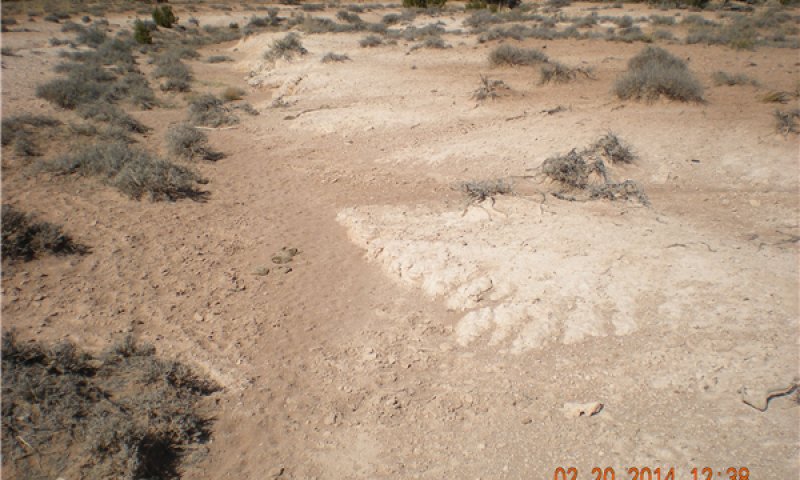
Figure 15. Winterfat/Juniper
The dominant aspect of this plant community is low growing shrub winterfat with a very light overstory of junipers. The understory may have blue grama and or snakeweed. The glaring attribute of this site is bare soil at or >70%
Pathway 1.1a
Community 1.1 to 1.2
Drought, unmanaged grazing
Conservation practices
| Prescribed Burning | |
|---|---|
| Upland Wildlife Habitat Management | |
| Prescribed Grazing | |
| Grazing Management Plan - Written |
Pathway 1.1b
Community 1.1 to 1.3


Drought, unmanaged grazing, seed source for juniper increase.
Pathway 1.2a
Community 1.2 to 1.1
Favorable climate (moisture), managed grazing, removal of disturbances.
Pathway 1.2b
Community 1.2 to 1.3
Lack of fire, unmanaged grazing, seed source for juniper increase.
Pathway 1.4
Community 1.3 to 1.1


This pathway can be accomplished through Prescribed grazing and mechanical means only. Seeding must be established to move this community phase towards the Reference State in 1.1
Conservation practices
| Conservation Cover | |
|---|---|
| Grazing Land Mechanical Treatment | |
| Range Planting | |
| Heavy Use Area Protection | |
| Vegetative Barrier | |
| Vegetated Treatment Area | |
| Controlled Livestock Lounging Area | |
| Native Plant Community Restoration and Management | |
| Prescribed Grazing | |
| Grazing Management Plan - Applied |
Pathway 1.3a
Community 1.3 to 1.2
Fire, managed grazing, seed sources for grasses
Additional community tables
Table 8. Community 1.1 plant community composition
| Group | Common name | Symbol | Scientific name | Annual production (kg/hectare) | Foliar cover (%) | |
|---|---|---|---|---|---|---|
|
Grass/Grasslike
|
||||||
| 1 | Dominant grasses | 280–443 | ||||
| needle and thread | HECOC8 | Hesperostipa comata ssp. comata | 62–112 | – | ||
| New Mexico feathergrass | HENE5 | Hesperostipa neomexicana | 62–112 | – | ||
| black grama | BOER4 | Bouteloua eriopoda | 56–84 | – | ||
| blue grama | BOGR2 | Bouteloua gracilis | 56–84 | – | ||
| squirreltail | ELELE | Elymus elymoides ssp. elymoides | 28–56 | – | ||
| sideoats grama | BOCU | Bouteloua curtipendula | 28–56 | – | ||
| James' galleta | PLJA | Pleuraphis jamesii | 28–56 | – | ||
| 2 | Other Cool Season Grasses | 39–123 | ||||
| western wheatgrass | PASM | Pascopyrum smithii | 0–34 | – | ||
| Indian ricegrass | ACHY | Achnatherum hymenoides | 0–34 | – | ||
| prairie Junegrass | KOMA | Koeleria macrantha | 0–22 | – | ||
| muttongrass | POFE | Poa fendleriana | 0–22 | – | ||
| Grass, annual | 2GA | Grass, annual | 0–6 | – | ||
| 3 | Other Warm Season Grasses | 39–90 | ||||
| low woollygrass | DAPU7 | Dasyochloa pulchella | 0–17 | – | ||
| ring muhly | MUTO2 | Muhlenbergia torreyi | 0–17 | – | ||
| spike dropseed | SPCO4 | Sporobolus contractus | 0–17 | – | ||
| sand dropseed | SPCR | Sporobolus cryptandrus | 0–17 | – | ||
| Grass, annual | 2GA | Grass, annual | 0–11 | – | ||
| threeawn | ARIST | Aristida | 0–11 | – | ||
|
Forb
|
||||||
| 4 | All forbs | 37–73 | ||||
| Forb, perennial | 2FP | Forb, perennial | 0–34 | – | ||
| Forb, annual | 2FA | Forb, annual | 0–17 | – | ||
| spike muhly | MUWR | Muhlenbergia wrightii | 6–11 | – | ||
| threeawn | ARIST | Aristida | 0–11 | – | ||
| hairy grama | BOHI2 | Bouteloua hirsuta | 0–11 | – | ||
| alkali sacaton | SPAI | Sporobolus airoides | 0–11 | – | ||
| spike dropseed | SPCO4 | Sporobolus contractus | 0–11 | – | ||
| sand dropseed | SPCR | Sporobolus cryptandrus | 0–11 | – | ||
| slim tridens | TRMU | Tridens muticus | 0–11 | – | ||
| vine mesquite | PAOB | Panicum obtusum | 0–11 | – | ||
| little bluestem | SCSC | Schizachyrium scoparium | 0–6 | – | ||
| low woollygrass | DAPU7 | Dasyochloa pulchella | 0–6 | – | ||
| hairy woollygrass | ERPI5 | Erioneuron pilosum | 0–6 | – | ||
| common wolfstail | LYPH | Lycurus phleoides | 0–6 | – | ||
| bush muhly | MUPO2 | Muhlenbergia porteri | 0–6 | – | ||
| ring muhly | MUTO2 | Muhlenbergia torreyi | 0–6 | – | ||
| Hall's panicgrass | PAHA | Panicum hallii | 0–6 | – | ||
| Grass, annual | 2GA | Grass, annual | 0–6 | – | ||
| sego lily | CANU3 | Calochortus nuttallii | 0–6 | – | ||
| whitemargin sandmat | CHAL11 | Chamaesyce albomarginata | 0–6 | – | ||
| rose heath | CHER2 | Chaetopappa ericoides | 0–6 | – | ||
| buckwheat | ERIOG | Eriogonum | 0–6 | – | ||
| whitestem blazingstar | MEAL6 | Mentzelia albicaulis | 0–6 | – | ||
| cleftleaf wildheliotrope | PHCR | Phacelia crenulata | 0–6 | – | ||
| little hogweed | POOL | Portulaca oleracea | 0–6 | – | ||
| globemallow | SPHAE | Sphaeralcea | 0–6 | – | ||
|
Shrub/Vine
|
||||||
| 5 | Dominant shrubs | 73–110 | ||||
| fourwing saltbush | ATCA2 | Atriplex canescens | 17–62 | – | ||
| Bigelow sage | ARBI3 | Artemisia bigelovii | 8–39 | – | ||
| jointfir | EPHED | Ephedra | 6–28 | – | ||
| bastardsage | ERWR | Eriogonum wrightii | 6–28 | – | ||
| winterfat | KRLA2 | Krascheninnikovia lanata | 6–28 | – | ||
| 6 | Other shrubs | 37–73 | ||||
| rabbitbrush | CHRYS9 | Chrysothamnus | 0–22 | – | ||
| Apache plume | FAPA | Fallugia paradoxa | 0–22 | – | ||
| snakeweed | GUTIE | Gutierrezia | 0–22 | – | ||
| Mexican cliffrose | PUME | Purshia mexicana | 0–22 | – | ||
| spineless horsebrush | TECA2 | Tetradymia canescens | 0–22 | – | ||
| woolly groundsel | PACA15 | Packera cana | 0–11 | – | ||
| Fremont's mahonia | MAFR3 | Mahonia fremontii | 0–11 | – | ||
| Subshrub (<.5m) | 2SUBS | Subshrub (<.5m) | 0–11 | – | ||
| desert sweet | CHMI2 | Chamaebatiaria millefolium | 0–11 | – | ||
| pricklypear | OPUNT | Opuntia | 0–6 | – | ||
| Whipple cholla | CYWH | Cylindropuntia whipplei | 0–6 | – | ||
|
Tree
|
||||||
| 7 | Trees | 15–39 | ||||
| oneseed juniper | JUMO | Juniperus monosperma | 0–22 | – | ||
| Utah juniper | JUOS | Juniperus osteosperma | 0–22 | – | ||
| twoneedle pinyon | PIED | Pinus edulis | 0–11 | – | ||
Interpretations
Animal community
This site is suitable for grazing during any period of the year by cows and calves, stocker cattle, sheep and horses. Prescribed grazing systems adapt well to this site.
The potential plant community provides a variety of food and cover plants for wildlife. Areas where rock outcrops occur are important cover areas for various species such as cottontail, wrens and reptiles.
Hydrological functions
This site is particularly susceptible to water erosion.
Recreational uses
Since this site is located on open plains and occasional broken topography showing exposed bedrock it has a variety of spring and summer flowering shrubs and forbs. Open grassland with occasional brushy thickets give the site good aesthetic appeal.
Winters are cold, however, relatively mild spring, fall and summer months are attractive to recreationists.
Hunting, rockhounding, wildlife observation, and horseback riding are activities suited to the site.
Wood products
Personal fuelwood cutting is possible on the lesser sloping areas.
Supporting information
Type locality
| Location 1: Apache County, AZ | |
|---|---|
| Township/Range/Section | T27E R2E S12 |
| General legal description | John Osborne Ranch |
Other references
Updates and revisions for this ESD were conducted as part of a 2007-2012 Interagency Technical Assistance Agreement between the Bureau of Indian Affairs–Navajo Region and the NRCS-Arizona.
Contributors
Ken Gishi
Larry D. Ellicott
Peter Lefebvre
Steve Barker
Rangeland health reference sheet
Interpreting Indicators of Rangeland Health is a qualitative assessment protocol used to determine ecosystem condition based on benchmark characteristics described in the Reference Sheet. A suite of 17 (or more) indicators are typically considered in an assessment. The ecological site(s) representative of an assessment location must be known prior to applying the protocol and must be verified based on soils and climate. Current plant community cannot be used to identify the ecological site.
| Author(s)/participant(s) | Karlyn Huling |
|---|---|
| Contact for lead author | NRCS State Rangeland Management Specialist, Phoenix, AZ |
| Date | 03/23/2006 |
| Approved by | Byron Lambeth |
| Approval date | |
| Composition (Indicators 10 and 12) based on | Annual Production |
Indicators
-
Number and extent of rills:
A few rills may occur on steeper slopes due to moderate permeability, rapid runoff and shallow depth of soils. They should be very uncommon in areas that have a lot of rock fragments on the surface and in the soil profile. -
Presence of water flow patterns:
Water flow patterns may be common due to moderate permeability, rapid runoff, and shallow depth of soils. Flow pattern will increase after drought dieback. There will be more water flow patterns on very shallow (<10") soils and in areas adjacent to large expanses of rock outcrop. -
Number and height of erosional pedestals or terracettes:
A few pedestals and terracettes may form, but they should be very short. -
Bare ground from Ecological Site Description or other studies (rock, litter, lichen, moss, plant canopy are not bare ground):
Bare ground ranges from 20-40%. Sites with a greater cover of rock fragments or bedrock have less bare ground. This site has an average water capacity of only 2 inches, so the potential to produce plant cover is very low, except in areas where plants have access to water in bedrock crops. Drought may cause an increase in bare ground. -
Number of gullies and erosion associated with gullies:
None -
Extent of wind scoured, blowouts and/or depositional areas:
None -
Amount of litter movement (describe size and distance expected to travel):
Herbaceous and fine woody litter will be transported in water flow pathways. Coarse woody litter will remain under shrub and tree canopies. Litter movement may be greater on very shallow soils or in areas adjacent to large expanses of rock outcrop. -
Soil surface (top few mm) resistance to erosion (stability values are averages - most sites will show a range of values):
Soil aggregate stability ratings average 5 under plant canopy and 3 in the interspaces. Many areas are protected by blue grama root mats and rock fragments. Soil surface textures range from sandy loam to clay loam. Many soils have a significant amount of rock fragment armor on the surface and in the profile. When well vegetated or covered with rock armor, soils have a high resistance to both water and wind erosion. -
Soil surface structure and SOM content (include type of structure and A-horizon color and thickness):
Surface structure is predominantly granular (weak fine, moderately fine and strong fine), but some soils have subangular blocky (weak to moderate, fine to medium) or massive surface structures. Some soils have a platy (weak, medium) surface structure. Surface thickness ranges from 1-12 inches. Surface colors vary depending on parent material. -
Effect of community phase composition (relative proportion of different functional groups) and spatial distribution on infiltration and runoff:
This site is characterized by a relatively uniform distribution of mostly grasses with some shrubs and a few forbs. Some locations have an open scattered tree canopy. Canopy cover averages 35% (20% grasses, 3% forbs, 10% shrubs, 2% trees). Basal cover of plants averages 10% (8% grasses, 1% forbs, 1% shrubs, trace moss/lichen). The cover (especially basal cover) is reduced by the amount of rock fragment ground cover. Both cover values (especially canopy cover) decrease during a prolonged drought. This type of plant community is moderately effective at capturing and storing precipitation. -
Presence and thickness of compaction layer (usually none; describe soil profile features which may be mistaken for compaction on this site):
None. These soils are not easily compacted due to large amount of rock fragments on the surface and in the profile. In areas without significant rock fragments, however,most soil types may be easily compacted when wet. One soil sometimes has a natural platy surface structure. -
Functional/Structural Groups (list in order of descending dominance by above-ground annual-production or live foliar cover using symbols: >>, >, = to indicate much greater than, greater than, and equal to):
Dominant:
cool season bunchgrassesSub-dominant:
warm season bunchgrasses > warm season colonizing grasses > shrubsOther:
Minor: forbs > trees > cacti
Trace: cool season colonizing grasses = annual grassesAdditional:
-
Amount of plant mortality and decadence (include which functional groups are expected to show mortality or decadence):
All functional groups are adapted for survival except during the most severe droughts. Severe winter droughts affect shrubs and trees the most. Severe summer droughts affect grasses the most. Very shallow (<10") soils will show the most mortality in all functional groups. -
Average percent litter cover (%) and depth ( in):
Mostly herbaceous litter, but up to 1/3 may be woody. There is generallyl less litter on rocky sites. Litter amounts increase during the first few years of drought, then decrease in later years. -
Expected annual annual-production (this is TOTAL above-ground annual-production, not just forage annual-production):
250-500 pounds per acre (dry weight) in drought years, 400-650 pounds per acre in median years, 550-800 pounds per acre in wet years. -
Potential invasive (including noxious) species (native and non-native). List species which BOTH characterize degraded states and have the potential to become a dominant or co-dominant species on the ecological site if their future establishment and growth is not actively controlled by management interventions. Species that become dominant for only one to several years (e.g., short-term response to drought or wildfire) are not invasive plants. Note that unlike other indicators, we are describing what is NOT expected in the reference state for the ecological site:
Greene rabbitbrush, Douglas rabbitbrush, broom snakeweed, baby aster and Whipple cholla re native to the site, but have the potential to increase and dominate the area after disturbance. Oneseed juniper is native to the site, but has the potential to increase and dominate after unmanaged grazing and/or fire exclusion. Russian thistle is an exotic forb that can invade the site from neighboring farm fields and disturbed lands if the soil is disturbed. -
Perennial plant reproductive capability:
All plants native to this site are adapted to the climate and are capable of producing seeds, stolons and rhizomes in all but the most severe droughts.
Print Options
Sections
Font
Other
The Ecosystem Dynamics Interpretive Tool is an information system framework developed by the USDA-ARS Jornada Experimental Range, USDA Natural Resources Conservation Service, and New Mexico State University.
Click on box and path labels to scroll to the respective text.